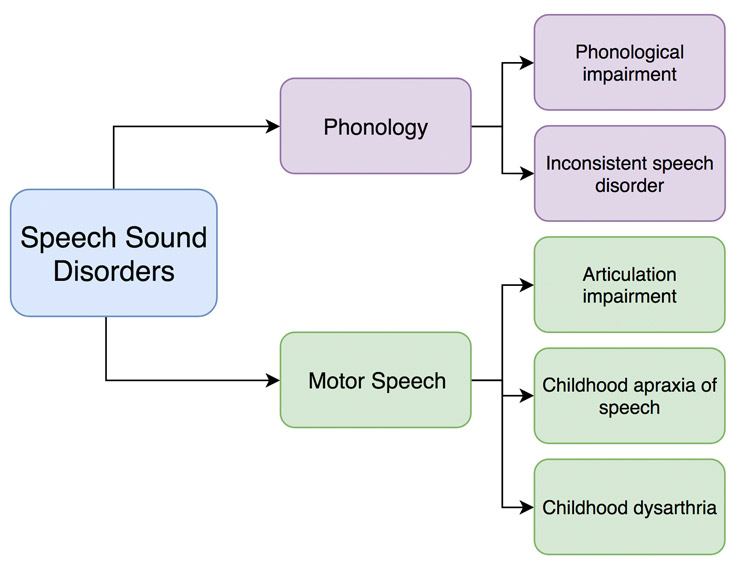Page content
SuSSD
Supporting and Understanding Speech Sound Disorder

Speech Sound Disorder (SSD) encompasses a range of difficulties that are both phonological and motoric in nature. This resource focuses on the clinical management of phonological impairment:
Diagram adapted from McLeod and Baker (2017):


- This resource is designed to support speech and language therapists (SLTs) to make clinical decisions about which (if any) intervention approach of the five included in this resource, is appropriate to use with specific children with phonological impairment.
- It is a prototype and is therefore still in the development stage and is awaiting further testing before specific recommendations may be made about which of the intervention approaches and intensities may be optimal for which children.
- Consequently, SLTs using the resource are encouraged to do so with critical reflection and to review each child’s progress on an ongoing basis being ready to change and adapt the intervention approach as appropriate.
- It is also important to note that only 3 approaches to the management of phonological impairment are considered here. There may be other, more appropriate approaches to the needs of specific children, that should also be considered in clinical decision making process.
- The decision-making flowchart within this website has been deliberately streamlined in its options, in accordance with the evidence-base, to reduce choice overload and decision-making fatigue (McCabe 2018) for SLTs.

This resource was designed to support speech and language therapists' evidence-based treatment of children with phonological impairment. This resource concentrates on assessment and intervention for 3 intervention approaches:
- Conventional minimal pairs;
- Multiple oppositions and;
- The complexity approaches: Maximal oppositions, empty set and 2/3-element clusters.
This resource has been developed to support SLTs use of research in practice with children with phonological impairment. However, the resource should be used alongside SLTs' own clinical judgement and experiences as well as their knowledge of the individual child.

- This resource was developed to support SLTs to use research in practice when working with children with phonological impairment.
- This resource was produced through Natalie Hegarty's PhD Studentship in Ulster University, Northern Ireland, funded by the Department for Employment and Learning (DEL).
- This resource was informed by the evidence-base and was co-produced with speech and language therapists from each of the Health and Social Care Trust’s in Northern Ireland (see acknowledgements below).
- The research team were: Natalie Hegarty, Jill Titterington (Ulster University), Sharynne McLeod (Charles Sturt University) and Laurence Taggart (Ulster University).

If you would like to get in touch please contact:
- Natalie Hegarty: Hegarty-N4@ulster.ac.uk
- Jill Titterington: J.Titterington@ulster.ac.uk
- Sharynne McLeod: smcleod@csu.edu.au
- Laurence Taggart: l.taggart@ulster.ac.uk

We appreciate and acknowledge the significant input of all the speech and language therapists from the five Health and Social Care Trusts in Northern Ireland (clinicians and managers alike) who facilitated and/or contributed to the successful co-production and face validity evaluation of SuSSD. Their input into the development of this resource has been fundamental to supporting its prospective clinical usefulness. Their names are listed in italics below (with their consent):
Jennie Adair, Hayley Andrews, Catherine Bonner, Rebecca Cushley, Ciara Fearon, Ceara Gallagher, Christine Harper, Una Isdell, Deirdre Lavery, Carolyn Lenny, Florence King, Hilary McFaul, Sarah McKinstry, Sinead Marlow, Eve Merrigan, Gillian Montgomery, Linda Mulgrew, Karen Rattray, Justine Smyth, Brid Tate, Alison Wilson and Lesley Wright.
The creators of this website would like to thank Dr Yvonne Wren, Dr Caroline Bowen and Dr Elise Baker for their informal review of, and feedback on SuSSD.

Please reference the website as follows:
Hegarty, N., Titterington, J., McLeod, S. and Taggart, T. (2018) SuSSD: Supporting and Understanding Speech Sound Disorders online resource, Ulster Universit
- This resource has been developed to support SLTs use of research in practice with children with phonological impairment. However, the resource should be used alongside SLTs' own clinical judgement and experiences as well as their knowledge of the individual child.
- Please note that this resource has been developed as part of a PhD project - therefore, only 3 intervention approaches are included. Other approaches are available and may be more appropriate for a child's difficulties.
Creative commons license ©2018
SuSSD: Supporting and understanding Speech Sound Disorder is licensed under a Creative Commons Attribution-NonCommercialNoDerivs 3.0 Unported License http://creativecommons.org/licenses/ by-nc-nd/3.0/ “That is, you are free to share — to copy, distribute and transmit the work with appropriate attribution and acknowledgment of the source. You may not use this work for commercial purposes. You may not alter, transform, or build upon this work.”
Please take a little time to answer these brief questions as you become familiar with the SuSSD site, fill in our feedback form.

















